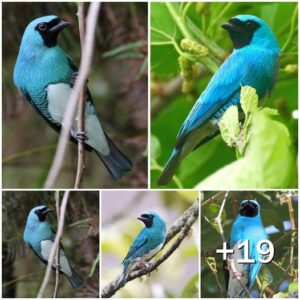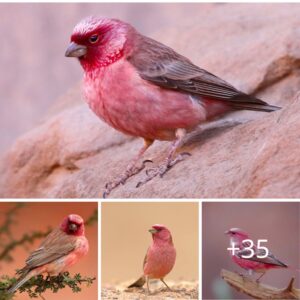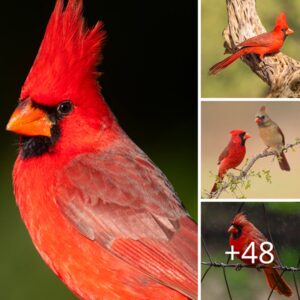Difficult to spot on the best of days, that is until they spread their wings becoming spectacular in flight, with their broad black, red, and white-spotted wings, in the process resembling a giant monarch butterfly.
Meet the Wallcreeper

“Wallcreeper – Alps – Italy_5037” by fveronesi1 is licensed under CC BY-SA 2.0.
Adult male Wallcreepers (Tichodromadidae) in breeding plumage have gray upper parts with a striking pattern on the broad, rounded wings. The carmine-red lesser and median coverts, along with red-pink on the alula, contrast with the duller primary and greater coverts. The flight feathers are dark gray with carmine-red bases on the outer edges and sooty black tips. Four outer primaries each have two white spots. The black upper tail has a gray tip and white edges on the external rectrices, giving the tail a short and squared appearance. The underparts of adult males consist of a black chin, throat, and breast (varying in extent among individuals), while the rest of the underparts are dusky gray. The underwing coverts and axillaries are pale red-pink.

Adult females differ slightly, with a grayish-white lower throat and upper breast with a black patch of variable size.
In non-breeding plumage, both sexes appear paler gray above with a whitish chin, throat, and breast, lacking the black throat patch. Juveniles resemble non-breeding adults but have a brownish throat and more uniformly gray plumage.

“Wallcreeper (Tichodroma muraria)” by gilgit2 is licensed under CC BY-SA 2.0.
The Wallcreeper is found in various rocky habitats such as steep cliffs, boulder-strewn slopes, gorges, and mountains. It requires holes and crevices for nesting and roosting. The habitat often includes rocky ledges, grass, moss, shrubs, trees, and areas with running water. During the winter, it frequents similar rocky areas at lower elevations, including cliffs near the sea and buildings in cities. The Wallcreeper can be found at elevations ranging from 350 to 3500 meters in Europe, predominantly higher in the Himalayas (between 1500 and 3600 meters), and even higher in Tibetan regions (up to 5000 meters).

“wallcreeper” by Paolo is licensed under CC BY 4.0.
The Wallcreeper is a vocal bird throughout the year. During the breeding season, it produces ascending clear whistles with a lower-end note. Outside of the breeding season, both males and females sing as advertising calls to establish their territories. The race “nepalensis” has a distinctive vocalization with rich whistled notes gently rising, followed by a high-pitched note. Short trills and warblers can also be heard from the Wallcreeper. Females tend to sing more frequently in the winter areas. Additionally, the Wallcreeper utters a whistled “tschirp” as a contact call.

Photo courtesy of Charles J. Sharp – Own work, from Sharp Photography, sharpphotography.co.uk/CC BY-SA 4.0
When foraging, the Wallcreeper usually searches for insects, spiders, and other invertebrates alone. It moves along rocky cliffs and walls using short, jerky hops, as well as sidling, creeping, and walking. It can perform upward leaps with the help of a single rapid wing beat on vertical surfaces. The Wallcreeper catches prey from the rock surface and vegetated ledges. It searches for insects in holes and tunnels, extracting invertebrates from rocky crevices. Occasionally, it may catch prey in flight or forage on the ground, using its closed bill to turn leaf litter. The Wallcreeper carries its largest prey to a flat stone and beats it against the surface until dismembered.

“Wallcreeper (Tichodroma muraria) 68” (cropped) by Nrik kiran is licensed under CC BY-SA 4.0.
The Wallcreeper is a migratory bird, primarily undertaking short-distance and altitudinal migrations depending on the season. During winter, it can be observed at lower elevations, including urban areas. Pairs of Wallcreepers form after returning from wintering areas. The male performs aerial displays near the chosen nest site, alternating glides and wing flapping within a small area, executing sharp turns, steep ascents, and dives. If a female approaches, the male enters the nest cavity while singing, and the singing continues inside. The male also displays a head-up posture to show off its black bib. Prior to copulation, the male sings persistently with its neck held forward and dropped wings. The male lands near the female and mounts her for copulation, which occurs a few days before egg-laying.

“wallcreeper” by Imran Shah is licensed under CC BY-SA 4.0.
During the breeding season, which takes place in April-May and July-August in Europe and May-July in the Himalayas, the Wallcreeper is monogamous and produces a single brood. It is a solitary nester and territorial, defending the nest site and territory against predators and intruders. The nest is typically located in a hole or cavity, such as a rock crevice, boulder, or even a building. The nest is constructed using materials like moss, plant fibers, rootlets, and grass. Once the chicks hatch, both parents participate in feeding them. The male brings food to the nest while the chicks come to the entrance to receive it. After about one month, the chicks fledge from the nest and begin to explore their surroundings. However, they still rely on their parents for several more days, typically between 5-6 and 7-12 days after leaving the nest. The female Wallcreeper lays a clutch of 3-5 eggs that are spotted and dark red to blackish in color. The incubation period, which is carried out by the female, lasts approximately 19 days. The young Wallcreepers reach sexual maturity at different ages depending on their gender. Females reach maturity at around one year of age, while males take approximately two years to reach sexual maturity.

“Wallcreeper (Tichodroma muraria)” by gilgit2 is licensed under CC BY-SA 2.0.
With its large, broad wings, the Wallcreeper takes advantage of updrafts in the mountains to reach higher foraging areas with minimal effort. Wing-flicking is a characteristic behavior of this species. The Wallcreeper exhibits agile flight with great maneuverability, allowing it to avoid attacks from predators.

“Wallcreeper (Tichodroma muraria)” by gilgit2 is licensed under CC BY-SA 2.0.
Although the Wallcreeper is fairly common, it can be challenging to observe due to its inaccessible mountain habitat. This species is protected in most European countries; however, it is classified as “critically endangered,” “vulnerable,” and “near threatened” in Poland, Liechtenstein, and Slovakia, respectively. In Germany, it is listed as red-listed. The Wallcreeper faces threats from human leisure activities in mountainous regions, such as rock climbing, which can disturb its breeding areas.

“wallcreeper” by Christoph Moning is licensed under CC BY 4.0.
Watch this bird right here in the video below:
This article uses material from Wikipedia.org which is licensed under the GNU Free Documentation License via Copyright Wikipedia. Images on this page are the sole property of the photographers (unless marked as Public Domain). Please read the license and or contact the photographers directly before using them for any purpose. Thank you all.



